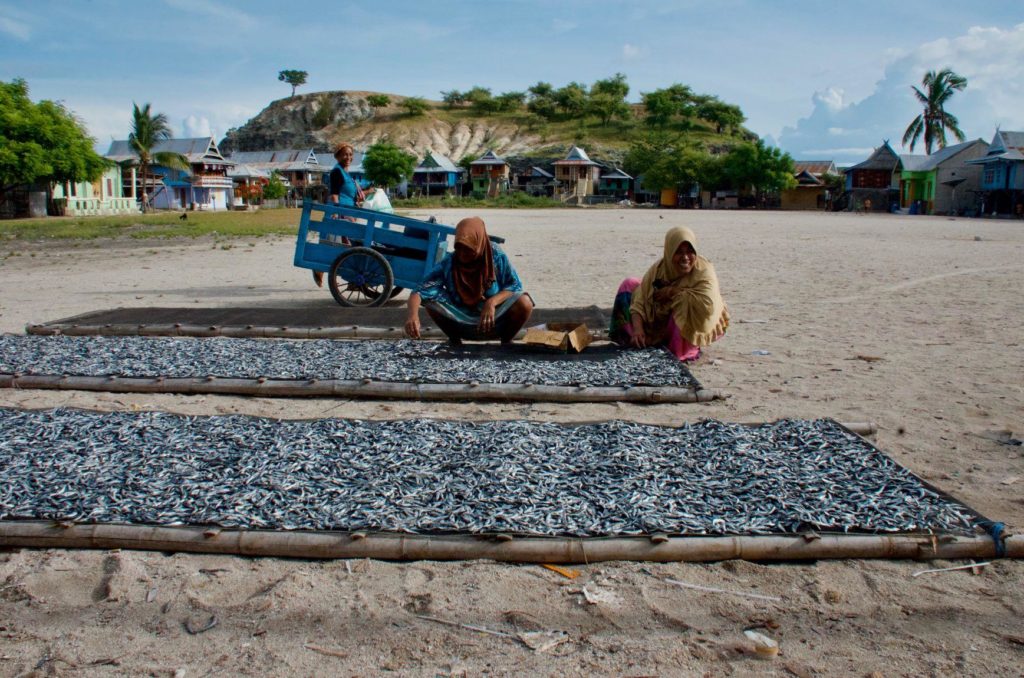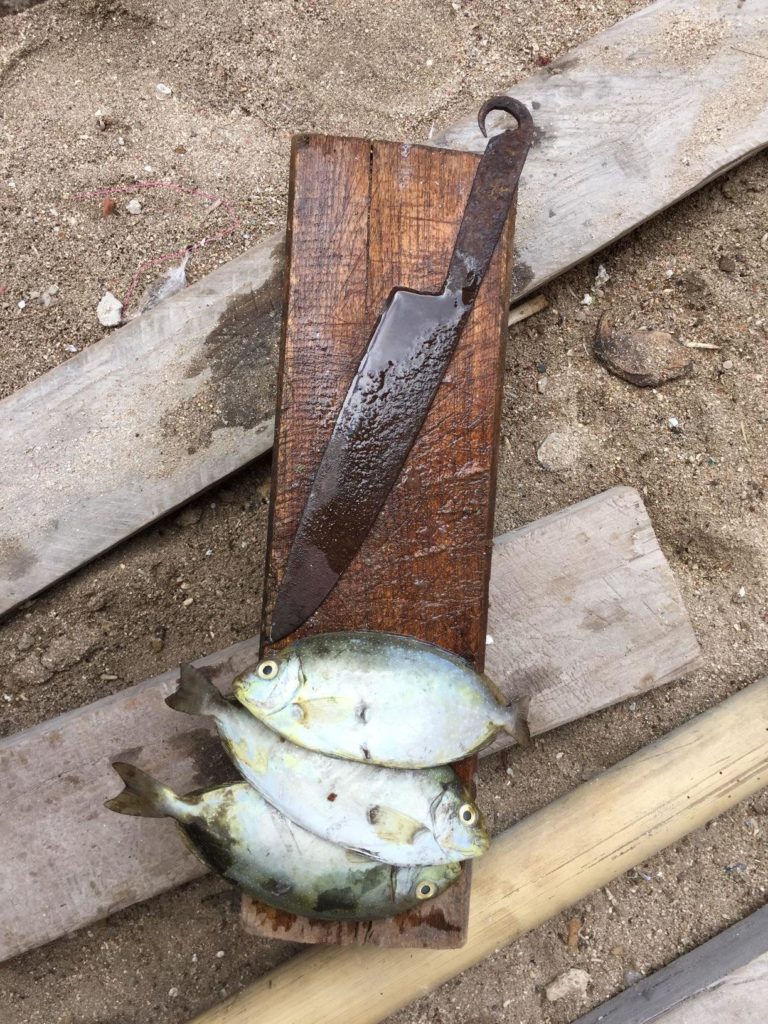Small-scale fisheries are recognised for the important opportunities they provide in terms of livelihoods and food and nutrition security. Women, men, the young and elderly, are engaged in different aspects of fisheries value chains, from assisting with preparations for fishing trips to fishing and gleaning, through to processing and marketing the resulting catch. At a household level, fishers harvest fish which can be consumed at home, or barter, exchange or sell the fish generating goodwill or income which can be used to acquire other foods. Fish are a highly nutritious animal-source food, providing protein, macro- and micronutrients which are essential for the cognitive development and growth of infants and children and for adult health. Recent research has highlighted the invaluable contribution that fish could make to the diets of women and children, particularly in the first 1000 days (from conception to two years of age).

Indonesia is the world’s second largest producer of fish, with the bulk of the catch produced by the small-scale sector which provides employment for an estimated 2.4 million households (MMAF, 2018). Indonesia is facing a double burden of malnutrition, with 36.4% of children under five having stunted growth and a quarter of adults overweight (Development Initiatives, 2019). And while Indonesia is actively promoting consumption of fish, there have been few studies exploring fish consumption at the household level and how this fits within broader dietary patterns.
Recognising that food and nutrition security is a multi-dimensional construct, encompassing availability, access, and utilisation of food and stability in each of these dimensions, we took a step back, using a case study approach, to investigate the extent of food and nutrition security in three specialised fishing communities in Komodo District, Nusa Tenggara Timur Province, Indonesia (Gibson et al., 2020). We focused on women and children because of their special nutrition needs, and evidence from other settings regarding inequities in the intrahousehold distribution of food (Thorne-Lyman et al., 2017).

We collected data on women’s and children’s food consumption in two 24-hour recall periods in two seasons (the wet and dry seasons of 2017-2018) from households across the three communities and used this data to calculate the minimum dietary diversity for women of reproductive age (MDDW) and children’s individual dietary diversity. We also collected anthropometry data. We conducted focus group discussions and semi-structured interviews to gain an understanding of livelihood activities, lean times, coping strategies, and gendered household and community roles.
We found that women’s and children’s diets fell short of the diversity necessary to provide adequate micronutrients. Less than one quarter of women consumed a diet comprising at least 5 of 10 food groups in either season, while just 24% of children consumed a diet comprising at least 4 of 7 food groups in the wet season, rising to 42% in the dry season. Diets were centred on rice, the major staple food in Indonesia. While most women regularly consumed fish, fish wasn’t introduced as a complementary food in the diets of younger children (especially 6-11 months) because of cultural taboos and fears about allergies or illnesses. Coupled with a general lack of fruits and vegetables in diets, children were at risk of micronutrient deficiency, and we found this expressed in very concerning levels of stunting among children (50%). On the other hand, we found the sweet and savoury snack foods (including processed foods) were consumed regularly by women and children, and 45% of women were overweight or obese.
A wide range of factors contribute to low dietary diversity in these communities.

The households in our study were specialised fishing households, with a strong socio-cultural fishing identity. Fishers diversified their fishing activity across target species, depending on their access to appropriate gear and links to boat-owning patrons. As well as supporting their husband’s fishing activities, women in nearly 40% of households had established home-based micro-businesses in food (e.g. cakes or bakso (Indonesia meat ball)) or petty trade. But the success of fishing livelihoods defined the flow of money into the communities: if the weather was bad and fishers were confined to shore, or harvests were low, women had to secure basic food on credit from kiosks or their spouses’ patron.
Poor soils and lack of fresh water meant there was no local cultivation of fruits and vegetables in these communities. Access to fresh foods was dependent on fishing income and a handful of traders who purchased fruits and vegetables in mainland markets and sold them in small kiosks. The lack of fresh water meant a portion of the household budget was allocated to water delivered in bulk, but water storage practices and general sanitation were poor, further acerbating health risks.
Basic health services were available in each of the communities, however, there were limited resources available for proactive preventative programs addressing healthy family diets and complementary feeding, and these messages competed with traditional knowledge and practices.
In addition qualitative ethnographic studies from Sulawesi suggest that the strongly gendered division of labour in fishing communities increases women’s risk of non-communicable diseases such as diabetes, with women’s comparatively sedentary home-based activities accompanied by frequent consumption of unhealthy foods (Asmal et al., 2020; Lampe et al., 2020).
This research highlights the need for a more nuanced exploration of food and nutrition security in fishing communities. Several frameworks (e.g. UNICEF’s determinants of malnutrition (1990), Kawarazuka and Bene’s contributions of fish to nutrition security (2010), and the food systems approach (2017)) map out the range of factors – across the four dimensions – that affect food and nutrition security. While constraining factors will differ in different settings, an improved understanding of these factors will better support the development of nutrition-sensitive fisheries programmes and policies. This will support the well-being of the women and men who work across fisheries value chains, and the vulnerable members of their households.
*Emily Gibson is a PhD candidate at the Research Institute for the Environment and Livelihoods at Charles Darwin University, Australia. Her research interests include the gendered dimensions of food systems in tropical coastal settings. She has over eight years work experience across the Indo-Pacific.
References
Asmal, I., Syarif, E., & Admad, M. (2020). Harmonization of domestic and social life of fishermen women; a positive behavior for quality of life. Enfermeria Clinica, 30(S2), pp. 518-523. doi:10.1016/j.enfcli.2019.07.151
Development Initiatives. (2019). Global Nutrition Report: Indonesia Country Overview. Bristol, UK: D. Initiatives. https://globalnutritionreport.org/resources/nutrition-profiles/asia/south-eastern-asia/indonesia/#profile
Gibson, E. C., Stacey, N., Sunderland, T. C. H., & Adhuri, D. S. (2020). Dietary diversity and fish consumption by mothers and their children in fisher households in Komdo District, eastern Indonesia. PLoS One, 15(4) doi:10.1371/journal.pone.0230777
HLPE (High Level Panel of Experts on Food Security and Nutrition). (2017). Nutrition and Food Systems. Rome: Italy
Kawarazuka, N., & Bene, C. (2010). Linking small-scale fisheries and aquaculture to household nutrition security: an overview. Food Security, 2, pp. 343-357.
Lampe, M., Waris, L., & Rajab, M. (2020). The influence of socio-economic gender’s roles towards diabetes symptoms in South Sulawesi fishermen community. Engermeria Clinica, 30(S2), pp. 140-143. doi:10.1016/j.enfcli.2019.07.065
MMAF (Ministry of Maritime Affairs and Fisheries). (2018). Marine and Fisheries in Figures 2018. Jakarta: Indonesia: MMAF.
Thorne-Lyman, A., Valpiani, N., Akter, R., Baten, M. A., Genschick, S., Karim, M., & Thilsted, S. H. (2017). Fish and meat are often withheld from the diets of infants 6 to 12 months in fish-farming households in rural Bangladesh. Food and Nutrition Bulletin, 38(3), pp. 354-368. doi:10.1177/0379572117709417
UNICEF. (1990). Strategy for Improved Nutrition of Children and Women in Developing Countries (Policy Review No. New York: USA: The United Nations Children’s Fund.
This entry was posted in: Fisheries, Indonesia
